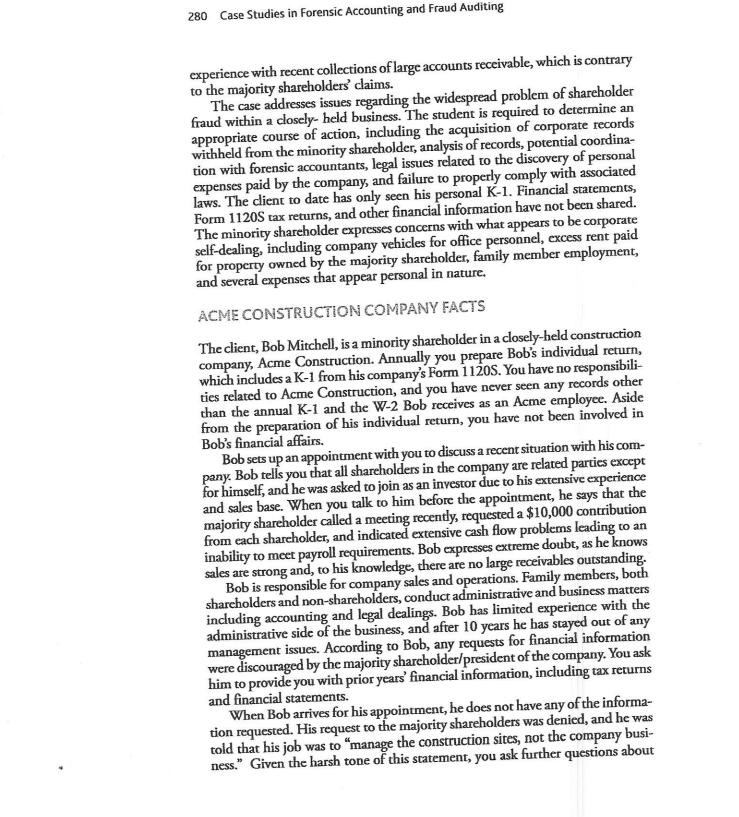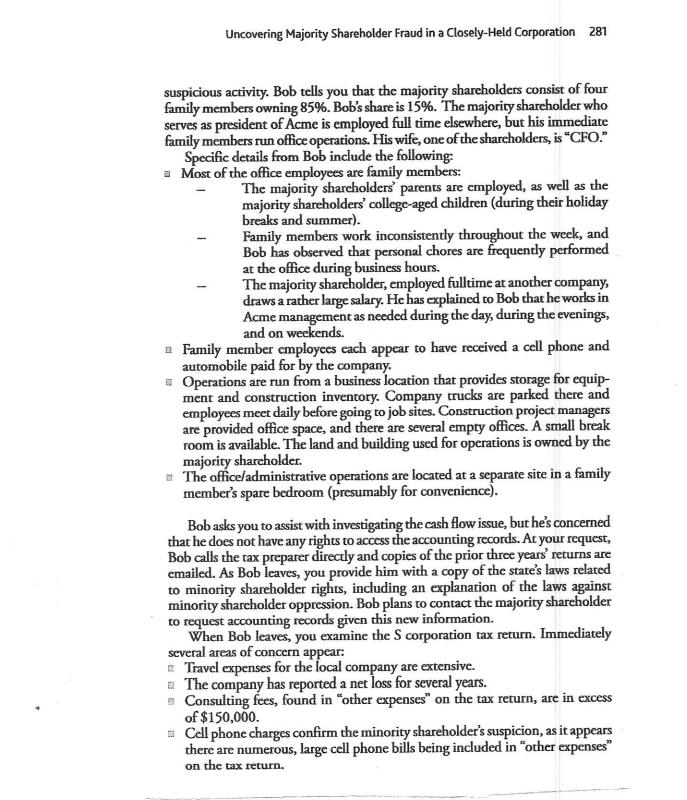Answered step by step
Verified Expert Solution
Question
1 Approved Answer
Financial irregularities often arise in closely-held businesses. When the major- ity shareholder controls the accounting records, employs family members, and conducts all legal and




Financial "irregularities" often arise in closely-held businesses. When the major- ity shareholder controls the accounting records, employs family members, and conducts all legal and accounting transactions, opportunities are abundant for self-dealing and breach of fiduciary duty. Students are placed in the role of a forensic accountant working with a small, closely held business in tax and financial statement preparation. A dient, a minority shareholder in a construction company, engages the accountant after the majority sharcholder states that cash flow is weak, salaries must be reduced, and shareholders must make cash contributions to maintain liquidity. The cli- ent expresses concerns with the cash flow situation due to his knowledge and 280 Case Studies in Forensic Accounting and Fraud Auditing experience with recent collections of large accounts receivable, which is contrary to the majority shareholders' claims. The case addresses issues regarding the widespread problem of shareholder fraud within a closely- held business. The student is required to determine an appropriate course of action, including the acquisition of corporate records withheld from the minority shareholder, analysis of records, potential coordina- tion with forensic accountants, legal issues related to the discovery of personal expenses paid by the company, and failure to properly comply with associated laws. The client to date has only seen his personal K-1. Financial statements, Form 1120S tax returns, and other financial information have not been shared. The minority shareholder expresses concerns with what appears to be corporate self-dealing, including company vehicles for office personnel, excess rent paid for property owned by the majority shareholder, family member employment, and several expenses that appear personal in nature. ACME CONSTRUCTION COMPANY FACTS The client, Bob Mitchell, is a minority shareholder in a closely-held construction company, Acme Construction. Annually you prepare Bob's individual return, which includes a K-1 from his company's Form 1120S. You have no responsibili- ties related to Acme Construction, and you have never seen any records other than the annual K-1 and the W-2 Bob receives as an Acme employee. Aside from the preparation of his individual return, you have not been involved in Bob's financial affairs. Bob sets up an appointment with you to discuss a recent situation with his com- pany. Bob tells you that all shareholders in the company are related parties except for himself, and he was asked to join as an investor due to his extensive experience and sales base. When you talk to him before the appointment, he says that the majority shareholder called a meeting recently, requested a $10,000 contribution from each shareholder, and indicated extensive cash flow problems leading to an inability to meet payroll requirements. Bob expresses extreme doubt, as he knows sales are strong and, to his knowledge, there are no large receivables outstanding. Bob is responsible for company sales and operations. Family members, both shareholders and non-shareholders, conduct administrative and business matters including accounting and legal dealings. Bob has limited experience with the administrative side of the business, and after 10 years he has stayed out of any management issues. According to Bob, any requests for financial information were discouraged by the majority shareholder/president of the company. You ask him to provide you with prior years' financial information, including tax returns and financial statements. When Bob arrives for his appointment, he does not have any of the informa- tion requested. His request to the majority shareholders was denied, and he was told that his job was to "manage the construction sites, not the company busi- ness." Given the harsh tone of this statement, you ask further questions about Uncovering Majority Shareholder Fraud in a Closely-Held Corporation 281 suspicious activity. Bob tells you that the majority shareholders consist of four family members owning 85%. Bob's share is 15%. The majority shareholder who serves as president of Acme is employed full time elsewhere, but his immediate family members run office operations. His wife, one of the shareholders, is CFO." Specific details from Bob include the following: Most of the office employees are family members: The majority shareholders' parents are employed, as well as the majority shareholders' college-aged children (during their holiday breaks and summer). Family members work inconsistently throughout the week, and Bob has observed that personal chores are frequently performed at the office during business hours. The majority shareholder, employed fulltime at another company, draws a rather large salary. He has explained to Bob that he works in Acme management as needed during the day, during the evenings, and on weekends. Family member employees each appear to have received a cell phone and automobile paid for by the company. Operations are run from a business location that provides storage for equip- ment and construction inventory. Company trucks are parked there and employees meet daily before going to job sites. Construction project managers are provided office space, and there are several empty offices. A small break room is available. The land and building used for operations is owned by the majority shareholder. The office/administrative operations are located at a separate site in a family member's spare bedroom (presumably for convenience). Bob asks you to assist with investigating the cash flow issue, but he's concerned that he does not have any rights to access the accounting records. At your request, Bob calls the tax preparer directly and copies of the prior three years' returns are emailed. As Bob leaves, you provide him with a copy of the state's laws related to minority shareholder rights, including an explanation of the laws against minority shareholder oppression. Bob plans to contact the majority shareholder to request accounting records given this new information. When Bob leaves, you examine the S corporation tax return. Immediately several areas of concern appear: Travel expenses for the local company are extensive. The company has reported a net loss for several years. e Consulting fees, found in "other expenses" on the tax return, are in excess of $150,000. Cell phone charges confirm the minority shareholder's suspicion, as it appears there are numerous, large cell phone bills being included in "other expenses" on the tax return. 282 Case Studies in Forensic Accounting and Fraud Auditing =Office rent is extremely large, in contrast to Bob's statement that the location of business operations are on property owned by the majority shareholder. An online search of ownership records for the county confirms this fact. Meals and entertainment expenses for the company are large, as are donations to charities. You call the signing tax preparer, who states that he does not review records. He only uses the Acme trial balance (prepared by the majority shareholder), updates depreciation, and has a staff member prepare the return based on the client's information. His nominal involvement is done to ensure the client fees are kept to a minimum. Bob returns the following week with electronic copies of the general ledger and financial statements. Bob and you pull up the information and project it on a screen to provide details of transactions in questionable accounts. Suspicions of self-dealing are confirmed, including several unexpected costs for personal expenses buried in the construction supplies expense account. It appears there are extensive issues with the due to/due from shareholder account, including mislabeled deposits and withdrawals, revealing considerable uncertainty as to the transactions recorded. Additionally, payroll tax withholding, including insurance and taxes, appears to be unreconciled and incorrect. REQUIRED: Identify the tax, legal, and potential fraud issues associated with Acme Construc- tion. How should these issues be investigated? What assistance will you need? How do you proceed? Provide details on your approach towards Bob, the share- holder, with the challenge he is facing in a company where he is affiliated as not just an owner but also as an employee. Write a report for your accounting firm's files and also write a letter to Bob. Thoroughly explain the approach you have chosen and the challenges faced in this situation. Consider IRC Section 162, Circular 230, and Statements on Standards for Tax Services.
Step by Step Solution
★★★★★
3.39 Rating (152 Votes )
There are 3 Steps involved in it
Step: 1
Identification of Issues Tax Issues Excessive Travel Expenses The companys extensive travel expenses raise questions about their legitimacy Net Losses Consistent net losses suggest financial mismanage...
Get Instant Access to Expert-Tailored Solutions
See step-by-step solutions with expert insights and AI powered tools for academic success
Step: 2

Step: 3

Ace Your Homework with AI
Get the answers you need in no time with our AI-driven, step-by-step assistance
Get Started


